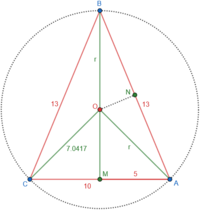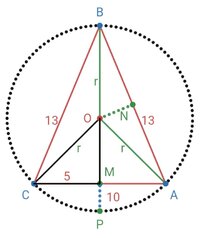You mean the that bit of whirrling uncertainty....As an aside, I've actually found that a bit of a buzz (not too heavy) makes Quantum Mechanics easier to understand.
Seriously!
-Dan
You are using an out of date browser. It may not display this or other websites correctly.
You should upgrade or use an alternative browser.
You should upgrade or use an alternative browser.
How do I find the radius of the circle? (An isosceles triangle ABC has its vertices on a circle....)
- Thread starter chijioke
- Start date
I don't. Ok please. Could you just mention the similar triangles and I will make equation and find r?That's not all. Do you have a systematic approach to finding all triangles with the given angle?
Dr.Peterson
Elite Member
- Joined
- Nov 12, 2017
- Messages
- 16,871
What other triangle(s) have the same angle as angle MBA?Could you just mention the similar triangles and I will make equation and find r?
And please at least try to think systematically, rather than saying you can't. That's what mathematics is all about.
lev888
Elite Member
- Joined
- Jan 16, 2018
- Messages
- 2,993
We can. But I think you should be more interested in filling gaps in your knowledge/skills than in getting the right answer as quickly as possible. If you don't see all triangles that share the given angle it's a problem. There are no shortcuts in math. If you don't understand something you will not be able to proceed to more complex topics.I don't. Ok please. Could you just mention the similar triangles and I will make equation and find r?
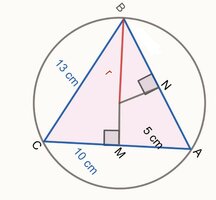
[math]r=\frac{13\times 6.5}{12} \approx 7cm[/math]This is my first time using geogebra to create and post a sketch in this forum. I think am going to create a new thread sometime later concerning some things I need to learn in creating geometrical shapes as its relates to maths. So where should such thread go? I mean which forum would be appropriate to fix such thread.
lev888
Elite Member
- Joined
- Jan 16, 2018
- Messages
- 2,993
Geometry and Trig forum sounds like a good match for posts about geometrical shapes.View attachment 36318
[math]r=\frac{13\times 6.5}{12} \approx 7cm[/math]This is my first time using geogebra to create and post a sketch in this forum. I think am going to create a new thread sometime later concerning some things I need to learn in creating geometrical shapes as its relates to maths. So where should such thread go? I mean which forum would be appropriate to fix such thread.
I mean asking about using Geogebra in creating some shapes.Geometry and Trig forum sounds like a good match for posts about geometrical shapes.
Dr.Peterson
Elite Member
- Joined
- Nov 12, 2017
- Messages
- 16,871
I'd still call it Geometry, since we don't have a Technology forum! And geometry helps a lot in using GeoGebra.I mean asking about using Geogebra in creating some shapes.
Actually, I usually don't even pay attention to where a question is; it doesn't matter much.
Dr.Peterson
Elite Member
- Joined
- Nov 12, 2017
- Messages
- 16,871
Yes, that looks right -- though it would help if you told us what triangles you used, and show the proportion itself.View attachment 36318
[math]r=\frac{13\times 6.5}{12} \approx 7cm[/math]This is my first time using geogebra to create and post a sketch in this forum. I think am going to create a new thread sometime later concerning some things I need to learn in creating geometrical shapes as its relates to maths. So where should such thread go? I mean which forum would be appropriate to fix such thread.
Here is my own GeoGebra drawing, showing that your answer is correct:
I used triangle BMA and BNO though I forgot to show the center point O when I was doing the construction.Yes, that looks right -- though it would help if you told us what triangles you used, and show the proportion itself.
Here is my own GeoGebra drawing, showing that your answer is correct:
jonah2.0
Full Member
- Joined
- Apr 29, 2014
- Messages
- 622
Beer induced algebraic alternative solution follows.
r^2=5^2+[(LengthofPO)-(Length of PM)]^2
r^2=5^2+[r-(2*r-12)]^2
View attachment 36318
[math]r=\frac{13\times 6.5}{12} \approx 7cm[/math]This is my first time using geogebra to create and post a sketch in this forum. I think am going to create a new thread sometime later concerning some things I need to learn in creating geometrical shapes as its relates to maths. So where should such thread go? I mean which forum would be appropriate to fix such thread.
What do I need to think in order to find PM. I no that BP = 2r
r^2=5^2+(Length of MO)^2View attachment 36266
View attachment 36267
i. Let the height [math]\overline{BM}~\text{be x}[/math][math]x=\sqrt{13^2-5^2}=12 cm[/math][math]\therefore[/math] the height of the triangle [math]\overline{BM}=12cm[/math]ii. So how can I obtain the radius of the circle?
r^2=5^2+[(LengthofPO)-(Length of PM)]^2
r^2=5^2+[r-(2*r-12)]^2
Dr.Peterson
Elite Member
- Joined
- Nov 12, 2017
- Messages
- 16,871
Yes, that's what my hints were intended to lead you to; so the proportion is [math]\frac{BO}{BN}=\frac{BA}{BM}\\\\\frac{r}{6.5}=\frac{13}{12}\\\\r=\frac{13\cdot6.5}{12}\approx7.0417[/math]I used triangle BMA and BNO though I forgot to show the center point O when I was doing the construction.
Two triangles are similar if the angles of one are respectively equal to the angle of the other.
Let's take a look at the triangle once again.
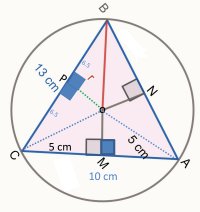
There are four similar Δ, -----, ΔPBO, ΔBON, ΔONA, and ΔPOC. All these Δs, are ~ to the two bigger congruent Δs, ΔBOC and ΔBOM. There are similar because all Δs have right angles.
Let say, I pick just two pairs of the Δs and compare them. We are comparing ΔPBO and ΔBOC.
Since [math]∠BPO = ∠OMC = 90 \degree[/math] Their corresponding sides are r and 13 cm.
My question now is, making reference to ΔPBO and ΔBOC, which other two angles are equal and why?
Let's take a look at the triangle once again.

There are four similar Δ, -----, ΔPBO, ΔBON, ΔONA, and ΔPOC. All these Δs, are ~ to the two bigger congruent Δs, ΔBOC and ΔBOM. There are similar because all Δs have right angles.
Let say, I pick just two pairs of the Δs and compare them. We are comparing ΔPBO and ΔBOC.
Since [math]∠BPO = ∠OMC = 90 \degree[/math] Their corresponding sides are r and 13 cm.
My question now is, making reference to ΔPBO and ΔBOC, which other two angles are equal and why?
Dr.Peterson
Elite Member
- Joined
- Nov 12, 2017
- Messages
- 16,871
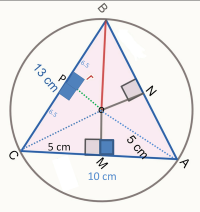
If we label according to corresponding parts, the triangles you refer to are ΔBOP, ΔBON, ΔAON, and ΔCOP, which are in fact congruent; these are similar to the larger triangles ΔBCM and ΔBAM (and others), not ΔBOC and ΔBOM, which are not right triangles (in fact, BOM isn't a triangle at all). What are you thinking??There are four similar Δ, -----, ΔPBO, ΔBON, ΔONA, and ΔPOC. All these Δs, are ~ to the two bigger congruent Δs, ΔBOC and ΔBOM. There are similar because all Δs have right angles.
Please correct your triangles and ask again. Did you mean ΔPBO and ΔMBC, perhaps?Let say, I pick just two pairs of the Δs and compare them. We are comparing ΔPBO and ΔBOC.
Since [math]∠BPO = ∠OMC = 90 \degree[/math] Their corresponding sides are r and 13 cm.
My question now is, making reference to ΔPBO and ΔBOC, which other two angles are equal and why?
I made mistake in my earlier post. This is what I intend to post.Please correct your triangles and ask again. Did you mean ΔPBO and ΔMBC, perhaps?
There are four similar Δ, -----, ΔPBO, ΔBON, ΔONA, and ΔPOC. All these Δs, are ~ to the two bigger congruent Δs, ΔBMC and ΔBMA. There are similar because all the Δs have right angles.
Let say, I pick just two pairs of the Δs and compare them. We are comparing ΔPBO and ΔMCB
Since
[math]∠BPO=∠OMC= 90 \degree[/math]Their corresponding sides are r and 13 cm.
My question now is, making reference to ΔPBO and MCB, which other two angles are equal and why?
I am asking so that we can establish similarity between the
Dr.Peterson
Elite Member
- Joined
- Nov 12, 2017
- Messages
- 16,871
These are all similar -- in fact, congruent -- but, again, it is clearer if you name them using corresponding parts, as ΔPBO, ΔNBO, ΔNAO, ΔPCO, and then ΔMBC and ΔMBA.There are four similar Δ, -----, ΔPBO, ΔBON, ΔONA, and ΔPOC. All these Δs, are ~ to the two bigger congruent Δs, ΔBMC and ΔBMA. There are similar because all the Δs have right angles.
Also, it is not enough to say that they are similar because they all have right angles; not all right triangles are similar. Do you see that the other angles I've marked as corresponding are all congruent? Or is that also part of your question?
In my terms, these are ΔPBO and ΔMBC; you're right about which angles are right angles (at P and M), but it would be clearer to name them ∠BPO and ∠BMC, for consistency. The sides you identify as corresponding are BO = r and BC = 13 cm; I suppose you say they are corresponding because they are the hypotenuse of each triangle?Let say, I pick just two pairs of the Δs and compare them. We are comparing ΔPBO and ΔMCB
Since
[math]∠BPO=∠OMC= 90 \degree[/math]Their corresponding sides are r and 13 cm.
I was thinking that you were claiming these are similar, since you talked about corresponding sides; how can you not already know which angles correspond? That is how you know the triangles are similar, and how I've been naming them.My question now is, making reference to ΔPBO and MCB, which other two angles are equal and why?
I am asking so that we can establish similarity between the[m]
Look at the triangles you refer to. Do you see that both have a vertex at B, and the angles there, ∠PBO and ∠MBC, are the same angle? That's why they correspond. (Angles at the same vertex in different triangles do not always correspond.)
Then, clearly, the other pair of vertices, O and C, also correspond, and are congruent. (What is that angle equal to?)
So, the first thing to do is to identify congruent angles, and so identify them as corresponding. Sometimes this is obvious, because they are the same angle; other times, it takes more thought (perhaps using parallel lines, or the fact that two angles are each half of congruent angles, and so on).

